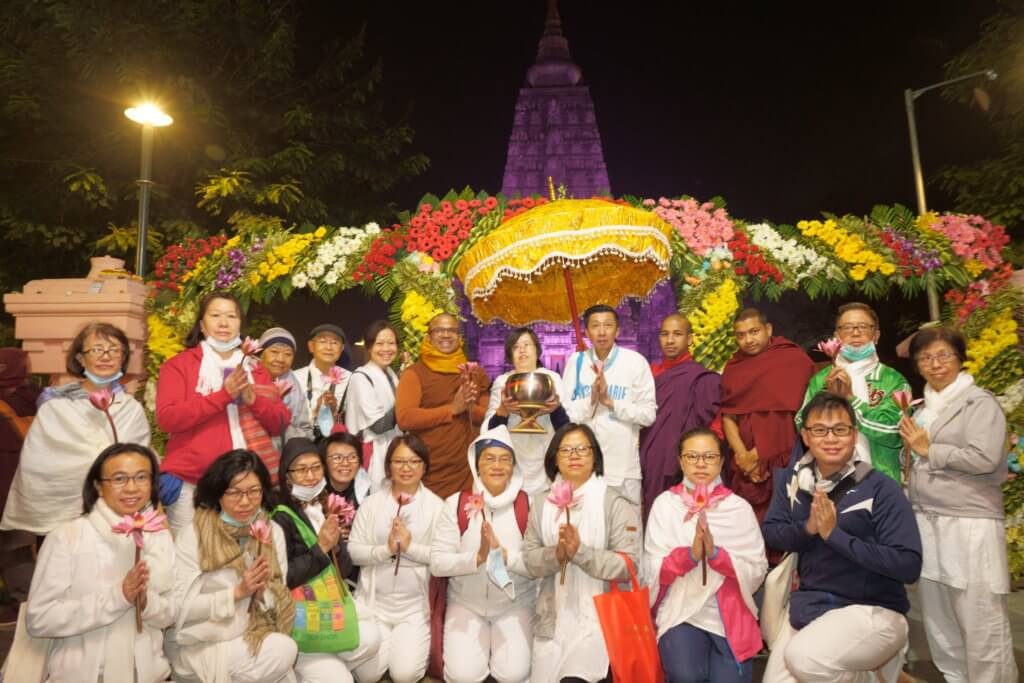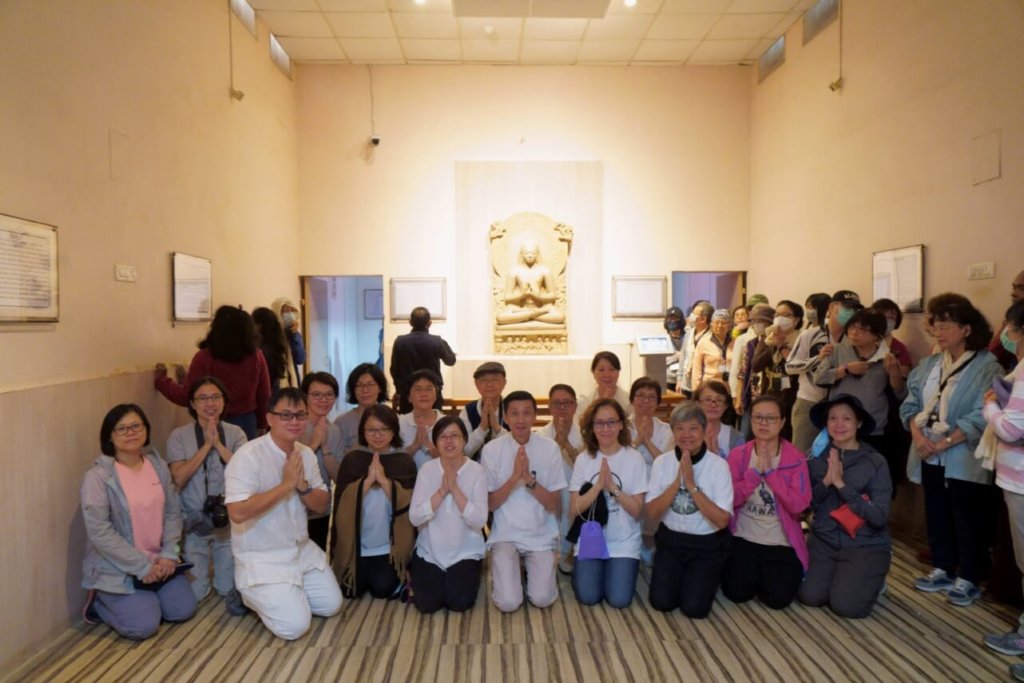
For many years, I found reason to put off going on a pilgrimage to India. It wasn’t until I read the Mahāparinibbāna Sutta (DN16) wherein the Lord Buddha mentioned to Venerable Ānanda the 4 places which should arouse the emotions of faithful monks, nuns, and lay followers after his passing. These are the locations of his birth, of his enlightenment, of his first sermon which set in motion the Wheel of the Dhamma, and of his attainment of Mahāparinibbāna.
The timing of Sister Dolly’s posting of the pilgrimage tour of 8 days/7 nights in February 2020 was ideal for me and I decided to take the plunge! Below is a recollection of the trip where all the teachings of the Buddha came alive for me.
Day One
Nineteen of us including Sister Dolly and accompanied by Mr Chong Voon Siong, the best tour manager with lots of Mettā from Ameriasa, braved the COVID-19 outbreak and departed for Varanasi on 4 February. India – here we come!!
Bhante Badullegama Siriwimala Thero who accompanied us on this pilgrimage joined us in Varanasi from Colombo. On arrival in Varanasi, we were greeted by the local tour guide, Mr SK Singh who is so humourous and ever so patient with our incessant questions. After our hotel check-in and dinner, we were taken on a big “sampan” for the sights and sounds as well as the “smell” of the Ganges River.
We cruised along the western bank of the Ganges River. The most memorable sights for me were the Aarti Puja performed by Brahmin priests to worship the Ganges River as well as the cremation ghat where cremations are carried out 24/7.
Day Two
The first holy site that we visited during our pilgrimage was Deer Park in Sarnath (known as Isipatana in the Buddha’s time). The Buddha delivered the First and Second sermons (Dhammacakkappavattana Sutta: Setting the Wheel of Dhamma in Motion and Anatta-lakkhana Sutta: The Discourse on the Not-self Characteristic) at this site.
The Buddha also spent his first vassa (rain retreat) after his enlightenment at this site. The ruins of Dharmarajika Stupa and Ashokan Pillar and the well-preserved Dhamekh Stupa mark this auspicious site. It really felt amazing that I was walking on the same grounds that the Lord Buddha walked on some 2,500 years ago!
Our next stop was the Chaukhandi Stupa situated about 1.7 km from Deer Park. It was at this site the Buddha first met the 5 friends/ascetics in Isipatana when he was traveling from Bodhgaya to Isipatana after his enlightenment to impart the Truth that he has discovered.
After Chaukhandi Stupa, we visited Sarnath Museum which houses many antiquities from the 3rd century BCE to 12th century AD. Among the antiquities are the original sandstone sculpture of the lion capital of Ashokan Pillar which is located in Deer Park – marking of 1st sermon. The Buddha in the Dharmacakra mudra (gesture of teaching) of the Gupta period is so captivating and breathtaking, yet so serene and calm for the senses.
In the evening, we visited the Sri Lankan Maha Bodhi Temple which was established by Anagarika Dhammapala and attended a chanting session of the Dhammacakapavatana Sutta by the Sri Lanka monks.
Day Three
After breakfast, we journeyed by road from Varanasi to Kushinagar (previously known as Kusinara). The journey took about 7 hours. Lunch at a government rest house was memorable as it served one of the most authentic and delicious India food!
We arrived in Kushinagar by early evening, checked into the hotel and had our dinner. We had planned for an evening chanting at a nearby Thai temple under the patronage of Royal Thai family but there was no chanting due to their preparation for the visit of a Thai princess. We were however granted a visit/tour of the temple grounds.
Day Four

Our first stop for the day was the Matha Kunwar shrine where the Buddha had a short rest before leaving for the Upavattan Sala Grove where he attained Mahāparinibbāna. The blue stone Buddha with Bhumiparsha mudra in the shrine is covered with gold leaves except for the head which is still in the original blue stone.
Next stop was Mahāparinibbāna Stupa which housed the reclining Buddha signifying his passing into Mahāparinibbāna. I couldn’t help but feel a little sombre inside the stupa. A short distance outside the stupa, there was a ruin which marked the actual spot where the Buddha passed into Mahāparinibbāna. The Buddha lay in state for six days after his passing in this stupa.
We also visited the Mukutbandhana Chaitya (Ramabhar Stupa) where the Buddha was cremated on the 7th day. The cremation ceremony was performed by Maha Kassapa and the Buddha’s relics were then distributed to 8 parts for the various kingdoms and republicans.
We left Kushinagar to head to Vaishali (Vesali in Buddha’s time). Enroute to Vaishali, we stopped at Kesariya Stupa. The Buddha gave his alms bowl to the Licchavis before he proceeded to Kusinara for his passing. The Licchavis’ built the Kesariya Stupa to enshrine the bowl. After this stop, we continued our journey to Vaishali, the land of the Vajjians.
Day Five

We visited the ruins of Vesali, the Ashokan Lion Pillar and the Buddha’s relic stupa built by Licchavi’s in the 5th century BCE enshrining 1/8 of the Buddha’s relics.
Vesali is well known because of Ambapali, the courtesan as well as for the setting up of the 1st Bhikkhuni order when the Buddha gave permission to Mahā Pajapatigotami. It was also in Vesali that the Buddha announced his impending passing in the next three months. The Buddha also chanted the Ratana Sutta in Vesali to get rid of disease and plague during the famine.
After lunch, we continued to travel to Bodhgaya but we were met with heavy traffic. A drive that was expected to take 6 hours turned into 10 hours. Being good and cool Buddhists, we took it in stride We were hoping to be Mahā Bodhi temple for evening puja on Chap Goh Mei but we finally reached after the Mahā Bodhi closed at 9 pm.
Day Six
Good news for us – even though we thought we missed Chap Goh Mei, we were informed that the Indian community celebrate the full moon a day later than us. Therefore, we were still in time for Mahā Bodhi for the full moon!
At 5 am in the morning, we proceeded to Mahā Bodhi temple with our milk rice offering. No words can describe my feelings at the Mahā Bodhi temple, it felt like a miniature earthquake within! We visited the seven sites within Mahā Bodhi to look at how the Buddha spent his first seven weeks after enlightenment.
A Mahā sanghika lunch dana was organized by the monks of the Bangladesh temple and there was much rejoicing. After lunch, we proceeded to Pragbodhi cave where the Buddha carried out self-mortification or extreme asceticism before his enlightenment. After Pragbodhi cave, we headed to Sujata Stupa and enroute to Sujata Stupa, we saw the Neranjara River which was dried up.
Day Seven
The day started with early morning meditation in Mahā Bodhi temple. I left with heavy heart when it is time to depart, aspiring to return soon. After breakfast, we flew from Bodhgaya to Varanasi. We visited a Jain temple on arrival in Varanasi and it was a real eye opener for most of us who are not exposed to Jainism, one of the surviving religions from 6th century BCE.
Day Eight
We returned to the Ganges River to see the sunrise, boarded the big “sampan” again and crossed to eastern bank of the river. We had a fun-filled morning on the eastern bank! We left Varanasi for Kuala Lumpur in the afternoon.
My appreciation to BGF/Sister Dolly, Bhante Wimala, Voon Siong, SK and rest of the pilgrims for making this memorable pilgrimage. Also, thank you to Bro Yap and Voon Siong for all the special moments captured on camera! Sadhu, Sadhu, Sadhu!
